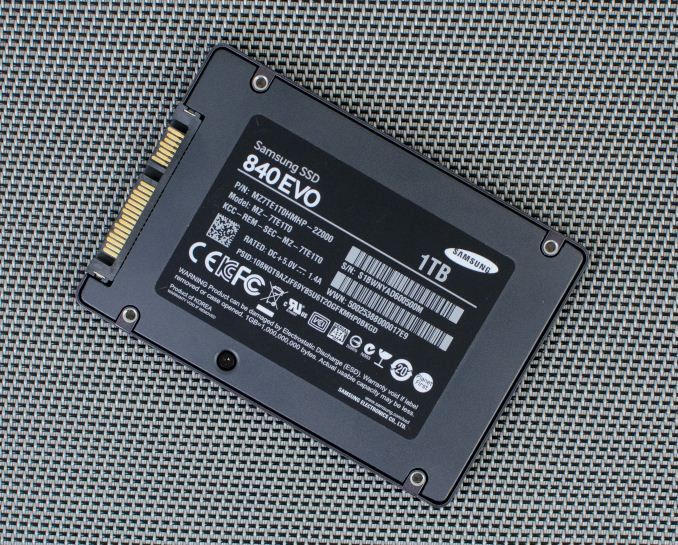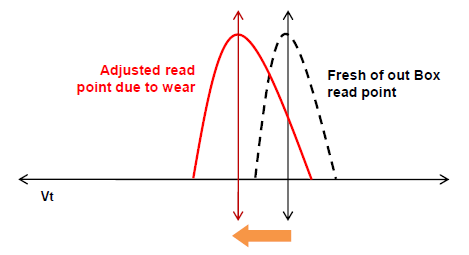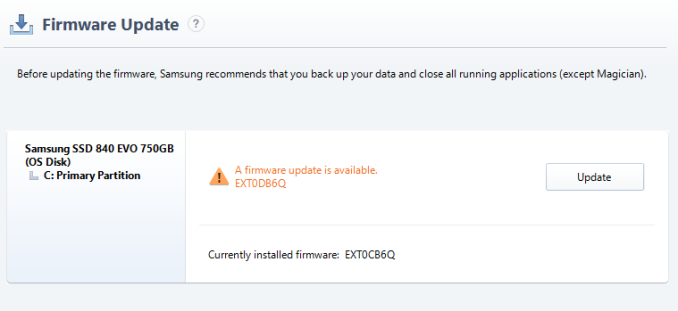Samsung Releases Second 840 EVO Performance Fix
by Ryan Smith on April 27, 2015 6:00 PM EST
If nothing else, the odyssey of Samsung’s 840 EVO has not been lacking in excitement. After initially launching in 2013 to great fanfare as an excellent, strong-performing low-cost drive, over the long run performance regressions began to occur in deployed drives that saw the read performance of old data significantly drop. At the heart of the issue was the drive’s relatively uncommon 19nm TLC NAND, which given the combination of small feature size and tighter requirements of TLC, eventually resulted in the drive having to slow down and re-read cells to properly read the charge-decayed cells.
Aiming to fix the issue, in 2014 Samsung released a performance restoration tool and firmware update for the 840 EVO. The combination of the tool and firmware would update the drive to better handle decayed cells and reduce the need to re-read them, meanwhile the restoration tool would refresh the drive’s data by re-writing all of the data to fresh cells. The idea being that fresh data in combination with the newer firmware would prevent the drive’s performance from decaying again.
Unfortunately that didn’t work out as planned, and while the data refresh from the performance restoration tool did bring drive performance back up, over the long run performance once again began decaying on old data, even with the firmware improvements. As a result Samsung has commissioned a second, more permanent fix for the 840 EVO. This fix involves another firmware update, this time installing a firmware that periodically refreshes old data rather than the one-off refresh of the performance restoration tool. Refreshing the data once again brings performance back up to where it should be, and the periodic, repeating nature of the refresh means that data is never allowed to get too old to let performance degrade again.
Ultimately Samsung’s second fix is a bit of a brute force solution to the problem, but at this point there doesn’t seem to be anything Samsung can do about 19nm TLC cell charge decay other than to refresh the data, as the problem is intrinsic to the NAND itself. Pre-release versions of the firmware show that this fix works, and conceptually this is much more likely to work over the long run than Samsung’s initial fix. The tradeoff is that it does consume P/E cycles to refresh the data, but by our own calculations even 5 years of refreshes at 1/week would only be 26% of the drive’s rated 1000 cycle lifetime. Meanwhile for the longer term, Samsung has since moved on to 3D-VNAND in newer drives, which is more stable than very small geometry planar NAND and essentially turns back the clock on NAND scaling issues. So the 840 EVO should be the last Samsung TLC drive to encounter this issue.
In any case, after previewing the updated firmware to the press, Samsung has released the updated firmware and its associated version of Samsung Magician (version 4.6) to the public over on their website. After an initial staggered release over the weekend – we suspect to make sure not too many users had the firmware if a problem quickly cropped up – Samsung looks to have opened downloads to everyone. However Mac and Linux users will want to note that at this time only the Magician version of the firmware has been released; the bootable ISOs for directly updating the drive have yet to be updated.
In the meantime this will continue to be an issue we keep an eye on. As with the initial problem and Samsung’s first fix, the decay issue only occurs after a time, so we’ll have to see where 840 EVO performance is in a couple months’ time. However with the very nature of the problem and the periodic refreshing of data, we’re hopeful that this will finally put an end to the performance degradation.
Source: Samsung












73 Comments
View All Comments
artasom - Tuesday, April 28, 2015 - link
It seems that they have uploaded the firmware for Mac and Linux users. However, the message that rests along with the link ("Supports Advanced Performance Optimization in Magician 4.6" ) is quite misleading, in my opinion, as this software is Windows-only. Which brings me to wonder how this fix will work in Mac and Linux as Magician software is not available for this OSes,,,Coup27 - Tuesday, April 28, 2015 - link
You definitely have a point regarding the description of the firmware.The answer to your question in theory at least is the firmware should work just as well. The new firmware is designed to automatically refresh (aka rewrite) old data to ensure it works at full speed. The advanced performance optimization is just a user initiated full drive rewrite. If you don't use that tool the drives firmware over time will rewrite any old data in the background.
At a guess I would say that after flashing the firmware the drive would rewrite all the data anyway so it starts from a clean slate so if you give your system a few hours of idle time after updating the firmware it should do the trick. I did run the advanced optimizer on my 120GB EVO and it took about 15 minutes.
artasom - Wednesday, April 29, 2015 - link
Thanks for your comment. Another matter that bothers me is the "power cycle" request. I have this SSD in a Macbook and in every firmware update it requests me to do a power cycle after applying the update. This means that I need to unscrew the bottom of the laptop, apply the firmware update and when requested to do the power cycle carefully remove the bottom plate, release the SSD, unplug it and plug it again... But I think this is not requested in Windows. Is it really necessary?Kristian Vättö - Wednesday, April 29, 2015 - link
Rebooting should also work. Power cycle essentially means that the drive needs to be powered off and then on again, which happens during a reboot.artasom - Thursday, April 30, 2015 - link
Thanks for your comment. Surprisingly, the firmware patching process took less that 10 seconds... This figure does not match to those that the users are reporting in Windows... Maybe the process is different than with the previous firmware update where all data was writen once when applying the update...Coup27 - Saturday, May 2, 2015 - link
artasom in reference to power cycling I think you are mixing up a secure erase (SE) and a firmware update. When performing an SE the drive says it is frozen and must be physically disconnected from the power while the system is on and then plugged back in before the SE can be ran. This is not required for a firmware update. After using Windows Magician to update the firmware the system automatically shuts down. Leaving it powered off for a few seconds before turning it back on is all that is required.The new firmware does have a different process to the previous update which was a 2 stage process. The first stage was the firmware update and shut down. After powering back on the 2nd stage was to rewrite the whole drive. This time around because the firmware will rewrite the drive in the background it is not necessary to include it into the firmware update process but for Windows users they can initiate a full drive rewrite using the feature in Magician.
The actual firmware update process takes a couple of seconds. Anybody who says it takes longer in Windows is either referring to the original update or including the time to run an "Advanced Performance Optimization" as well.
leexgx - Thursday, April 30, 2015 - link
a power cycle is a restart of system or just shut downtaking the SSD out was bit over the top as you would of had to shut the mac down and take the battery out to get to do it :)
Maltz - Wednesday, June 3, 2015 - link
A restart is NOT a power-cycle. The PSU continues to supply power to the drive through a restart. You have to shut the machine down and turn it back on. Putting it to sleep and waking it back up will also probably power-cycle the drive, which is useful for power-cycling the drive without rebooting, to unfreeze the drive's security settings when doing a secure erase, for example.Achaios - Tuesday, April 28, 2015 - link
Many thanks to ANANDTECH and in particular, Ryan and Kristian, for pursuing the matter and keeping us updated.michal1980 - Tuesday, April 28, 2015 - link
thanks? How about they stop whitewashing the issue. They somehow think a 26% reduction in product life is acceptable.